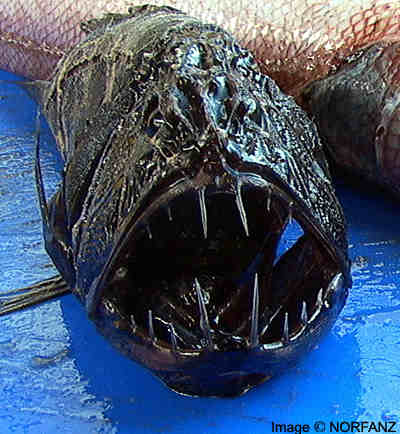|
| Query: Common fangtooth | Result: 5th of 6 | |
Fangtooth Anoplogaster cornuta (Valenciennes, 1833) <!--귀신고기-->
| Subject: | Fangtooth Anoplogaster cornuta (Valenciennes, 1833)
| |

| Resolution: 400x434
File Size: 25075 Bytes
Upload Date: 2005:11:05 23:46:44
|
ERROR : Server Busy(-1105)
ERROR : Server Busy(-1105)
Fangtooth Anoplogaster cornuta (Valenciennes, 1833)
Fangtooth
Anoplogaster cornuta (Valenciennes, 1833)
[Photo] A 109mm standard length Fangtooth trawled during the NORFANZ expedition at a depth between the surface and 1275m in international waters south of Norfolk Island, May 2003 (CSIRO H6003-01). Photo: M. Norman ?? NORFANZ.
The fangtooth has a short deep body with a large head and mouth. The body is covered with small prickly scales. The distinct lateral line is an open groove partially covered by scales. There are mucous cavities on the head separated by serrated ridges. As the common name suggests, this fish has very long pointed teeth. The lower jaw fangs slide into pockets in the roof of the mouth when the jaws close.
This species is dark brown to black.
Adults and juveniles look very different. Juveniles have long head spines and are light grey. They don't begin to look like adults until they reach about 8cm in length. Adults and juveniles look so different they were described as a different species in the 1800s.
The Fangtooth grows to 17cm in length.
Juveniles eat crustaceans and adults eat fishes.
This species occurs in bathypelagic and mesopelagic depths down to 4992m. It most common between 500m and 2000m, in temperate marine waters worldwide.
In Australia it is known from off central to southern New South Wales.
Source: http://www.amonline.net.au/fishes/fishfacts/fish/acornuta.htm
Australian Museum http://www.amonline.net.au |
^o^
Animal Pictures Archive for smart phones
^o^
|
|